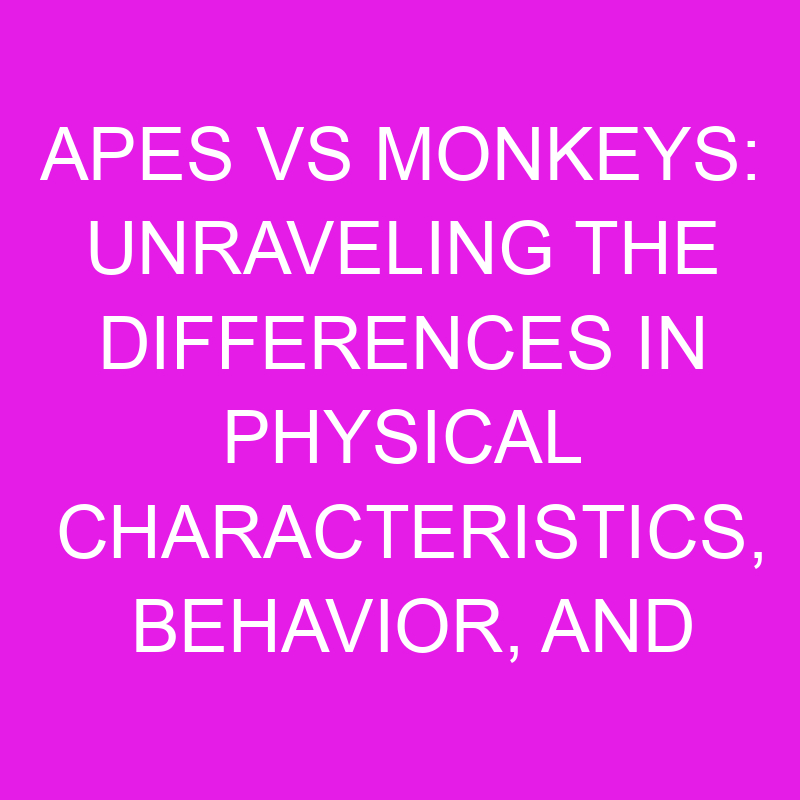
When it comes to primates, there’s often confusion between apes and monkeys. While they may share some similarities, there are distinct differences that set them apart. As a primatology enthusiast, I’ve delved into the fascinating world of these intelligent creatures and I’m here to shed some light on the dissimilarities between apes and monkeys.
Firstly, let’s talk about their physical characteristics. Apes, such as gorillas and chimpanzees, have a more robust body structure with a larger size compared to monkeys. They also lack a tail, which is a defining feature of monkeys. Monkeys, on the other hand, come in a variety of shapes and sizes, and most species have a long, flexible tail that they use for balance and communication.
Another key distinction lies in their behavior and social structures. Apes are known for their complex social interactions and are capable of forming strong bonds within their groups. They exhibit more advanced cognitive abilities, including tool usage and problem-solving skills. Monkeys, while also social creatures, tend to have simpler social structures and rely more on instinctual behaviors.
Post Contents
- Physical Characteristics of Apes and Monkeys
- Differences in Body Structure
- The Role of Tails
- Behavioral Contrasts between Apes and Monkeys
- Social Structures of Apes and Monkeys
- Conclusion
- Frequently Asked Questions
- Q: What are some physical characteristics of apes and monkeys?
- Q: How do apes and monkeys behave?
- Q: Do apes and monkeys live in groups?
- Q: How do apes and monkeys establish dominance?
- Q: Do apes and monkeys have social bonds?
- Q: How do apes and monkeys mate?
- Q: What can we learn from the social structures of apes and monkeys?
Physical Characteristics of Apes and Monkeys
When it comes to the physical characteristics of apes and monkeys, there are some key differences to take note of.
Size and Tail
Apes, such as gorillas and chimpanzees, tend to be larger in size compared to monkeys. Apes can range in height from about 2 to 6 feet and can weigh anywhere from 20 to 400 pounds. In contrast, monkeys come in various shapes and sizes, with some smaller species measuring just a few inches and weighing only a few ounces.
One noticeable physical difference between apes and monkeys is the presence of a tail. Apes, including orangutans and gibbons, completely lack a tail. On the other hand, monkeys have long, flexible tails that they use for balance, communication, and even as a tool to grasp objects.
Limb Structure
Another distinction between apes and monkeys lies in their limb structure. Apes have arms that are proportionally longer than their legs, allowing them to swing through trees effortlessly. Monkeys, in comparison, have a more balanced limb structure, with arms and legs of equal length. This enables them to move both on the ground and in trees with relative ease.
Facial Features
When it comes to their facial features, apes and monkeys also have some differences. Apes generally have larger, more prominent facial features, including a larger skull and a protruding face. Monkeys, on the other hand, have a more varied range of facial structures, depending on their species. Some monkeys have round faces with small features, while others may have elongated snouts or distinctive coloring.
Dental Formula
Lastly, the dental formula of apes and monkeys is also worth mentioning. Apes typically have a dental formula of 2-1-2-3, which means they have two incisors, one canine, two premolars, and three molars. Monkeys, on the other hand, have a more diverse range of dental formulas, depending on their species. For example, some monkeys may have a dental formula of 2-1-3-3, while others may have a dental formula of 2-1-2-2.
Overall, the physical characteristics of apes and monkeys provide us with fascinating insights into their unique adaptations and evolutionary pathways. Understanding these differences helps us appreciate the diversity of primates and their remarkable ability to adapt to a wide range of environments.
Differences in Body Structure
When it comes to body structure, apes and monkeys have several key differences. These differences not only affect their physical appearance but also play a significant role in their behavior and lifestyles.
Size and Proportions
Apes tend to be larger in size compared to monkeys. They can range in height from 2 to 6 feet and weigh anywhere from 20 to 400 pounds. Some of the largest apes, such as gorillas, can even reach heights of over 6 feet and weigh up to 400 pounds. On the other hand, monkeys are generally smaller and lighter, with a height range of 1 to 3 feet and a weight range of 4 to 50 pounds.
In terms of proportions, apes have arms that are proportionally longer than their legs, allowing them to swing through trees with incredible agility. Monkeys, on the other hand, have a more balanced limb structure, which enables them to walk, run, and climb trees with ease.
Tail or No Tail
One of the most obvious differences is the presence or absence of a tail. Apes do not have tails, while monkeys have long, flexible tails that they use for balance and communication. The absence of a tail in apes gives them greater freedom and flexibility in their movements, especially in their arboreal habitats.
Facial Features
When it comes to facial features, apes generally have larger and more prominent facial structures. Their skulls are larger, with a protruding face. This is particularly noticeable in great apes like gorillas and chimpanzees. On the other hand, monkeys display a more varied range of facial structures, with some having smaller or flatter faces.
Dental Formula
Another key difference between apes and monkeys is their dental formula, which refers to the number and arrangement of teeth in their mouths. Apes typically have a dental formula of 2-1-2-3, meaning they have two incisors, one canine, two premolars, and three molars on each side of their jaw. Monkeys, on the other hand, have a more diverse range of dental formulas, with variations in the number and arrangement of their teeth.
The Role of Tails
Tails play a crucial role in distinguishing apes from monkeys. While apes lack tails altogether, monkeys have long, flexible tails that serve various purposes. Let’s delve into the significance of these appendages.
Balance and Communication
Monkeys use their tails as a balancing tool while moving through the trees and navigating their environment. The tail acts like a counterbalance, helping them to maintain stability and agility while leaping, swinging, and climbing. It’s an incredible adaptation that allows monkeys to effortlessly traverse the canopy.
Additionally, the tail serves as a means of communication among monkeys. They use it to signal emotions, intentions, and warnings to other members of their group. This tail communication is particularly valuable in dense forest environments where visual communication can be challenging.
Absence of Tails in Apes
Apes, on the other hand, have no need for tails due to their different locomotion style. They primarily employ a form of movement called brachiation, swinging from branch to branch using their arms. The absence of a tail grants apes more freedom of movement and flexibility, allowing them to navigate through the trees with unmatched grace and speed.
Notable Exception: Gibbons
It’s important to note that among apes, gibbons are an exception to the no-tail rule. Although they are technically classified as apes, gibbons possess tails that are considerably different from monkeys. Their tails, known as “pseudo-tails,” are not prehensile like monkeys’ tails. Instead, they are shorter and less flexible, serving more as a stabilizer during their remarkable acrobatics.
Understanding the significance of tails in distinguishing apes from monkeys sheds light on the diverse adaptations and lifestyles of these remarkable primates. With their lack of tails, apes have evolved a specialized mode of locomotion, while monkeys have developed a versatile tool that aids in their movement and social interactions.
Behavioral Contrasts between Apes and Monkeys
When it comes to behavior, there are several key contrasts between apes and monkeys. These distinctions shed light on the diverse adaptations and lifestyles of these remarkable primates.
1. Social Structure:
Apes, such as chimpanzees and gorillas, exhibit a more complex social structure compared to monkeys. They live in cohesive groups, where individuals form strong social bonds and engage in various social interactions. Monkeys, on the other hand, have a more flexible social structure. While some species form relatively stable groups, others live in more fluid social networks.
2. Communication:
Communication styles also differ between apes and monkeys. Both groups use vocalizations, facial expressions, and body language to convey messages, but the complexity of communication is greater in apes. For example, apes have been observed using gestures and signs to communicate specific meanings. Monkeys primarily rely on vocalizations and visual displays for communication.
3. Tool Use:
Apes are well-known for their ability to use tools. They have been observed fashioning and using tools for various purposes, such as extracting insects from tree trunks or cracking open nuts. Monkeys, on the other hand, have a more limited tool-use repertoire. While some monkey species exhibit rudimentary tool use, such as using rocks as hammers, their tool use is generally less sophisticated than that of apes.
4. Problem-Solving Skills:
Apes, especially chimpanzees, possess impressive problem-solving abilities. They are capable of using abstract reasoning and can solve complex puzzles. Monkeys, although intelligent in their own right, typically demonstrate less advanced problem-solving skills compared to apes. Their cognitive abilities are often focused on immediate tasks or environmental challenges.
5. Reproduction and Parenting:
Apes and monkeys also differ in their reproductive strategies and parenting behaviors. Apes have a longer gestation period and usually give birth to single offspring. They invest a great deal of time and effort into parenting, with both males and females contributing to the care of their young. Monkeys, on the other hand, have shorter gestation periods and often give birth to multiple offspring. Parenting responsibilities are primarily carried out by females, although some males may assist with offspring care.
Social Structures of Apes and Monkeys
Apes and monkeys differ not only in their physical characteristics and behavior but also in their social structures. Understanding the social dynamics of these primates is crucial to comprehending the distinctions between them. Let’s take a closer look at the social structures of apes and monkeys.
Apes:
- Complex social structure: Apes, such as chimpanzees and gorillas, live in complex social groups that consist of multiple males, females, and their offspring. These groups are known as “troops” and can vary in size from a few individuals to over 50 members.
- Hierarchy: Within the troop, there is a clear hierarchy, with dominant individuals having more access to resources and mating opportunities. This hierarchy is established through displays of power and aggression and can change over time.
- Long-term relationships: Apes form long-lasting relationships within their troops. They develop strong social bonds, especially between mothers and their offspring and between closely related individuals.
- Flexible social structure: Monkeys, such as macaques and baboons, have a more flexible social structure compared to apes. They live in groups called “troops” or “bands” that can vary in size and composition. These groups may consist of several adult males, females, and juveniles.
- Male dominance: In monkey troops, dominance is often determined by the size and strength of male individuals. Dominant males have priority access to resources and mating opportunities.
- Multimale-multifemale mating: Monkeys generally practice multimale-multifemale mating, meaning that both males and females have multiple mating partners within the troop.
By studying the social structures of apes and monkeys, we gain insights into how these fascinating primates interact and cooperate within their respective groups. The intricate social hierarchies and long-lasting bonds exhibited by apes contrast with the more flexible and male-dominated social structures of monkeys. This understanding further enriches our understanding of the diversity and complexity of the primate world.
Conclusion
The article has explored the key differences between apes and monkeys, focusing on their physical characteristics, behavior, and social structures. Apes, such as chimpanzees and gorillas, exhibit complex social hierarchies within their troops, forming strong social bonds and long-lasting relationships. On the other hand, monkeys, like macaques and baboons, have a more flexible social structure where dominance is often determined by the size and strength of males. Monkey troops practice multimale-multifemale mating.
Understanding the social structures of apes and monkeys provides valuable insights into their interactions and cooperation within their respective groups. It highlights the remarkable diversity and complexity of the primate world. By delving into these differences, we gain a deeper appreciation for the unique qualities and adaptations that make each species thrive in their environments.
Ultimately, both apes and monkeys play crucial roles in maintaining the delicate balance of ecosystems and contribute to the rich tapestry of life on our planet. Studying these fascinating creatures not only expands our knowledge but also fosters a greater understanding of our own place in the natural world.
Frequently Asked Questions
Q: What are some physical characteristics of apes and monkeys?
A: Apes, like chimpanzees and gorillas, have larger bodies, long arms, and no tails. Monkeys, such as macaques and baboons, have tails, smaller bodies, and longer hind limbs.
Q: How do apes and monkeys behave?
A: Apes are known for their intelligence and tool-making abilities. They also display complex social behaviors, including cooperation and communication. Monkeys are more agile and have a wide range of behaviors, including grooming, playing, and territorial displays.
Q: Do apes and monkeys live in groups?
A: Yes, both apes and monkeys live in groups. Apes, like chimpanzees and gorillas, live in troops with a clear hierarchy. Monkeys, such as macaques and baboons, live in troops with a more flexible social structure.
Q: How do apes and monkeys establish dominance?
A: In apes, dominance is established through a hierarchical structure based on age, size, and strength. Monkeys establish dominance based on the size and strength of male individuals.
A: Yes, both apes and monkeys form social bonds within their respective groups. Apes, in particular, form long-lasting relationships and strong social bonds with other group members.
Q: How do apes and monkeys mate?
A: Apes have a more selective mating system, with dominant males mating with multiple females. Monkeys, on the other hand, practice multimale-multifemale mating, where multiple males mate with multiple females.
A: Understanding the social structures of apes and monkeys provides insights into their interactions and cooperation within their respective groups. It also highlights the diversity and complexity of the primate world.





